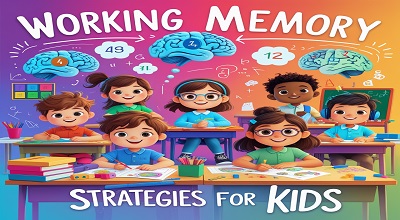Working Memory Strategies for Kids
Working Memory Strategies for Kids: Working memory is a crucial cognitive function that allows children to hold and manipulate information in their minds for short periods. It plays a vital role in learning, problem-solving, and following instructions in the classroom. However, many kids struggle with working memory limitations, which can affect their academic performance.
In this comprehensive guide, we will explore effective working memory strategies for kids, backed by the latest research, to help educators and parents enhance learning experiences in the classroom.
Understanding Working Memory in Children
What Is Working Memory?
Working memory is the brain’s temporary storage system that allows individuals to hold and process information for short periods. Unlike long-term memory, which stores information indefinitely, working memory is limited in capacity and duration.
How Does Working Memory Develop in Kids?
Working memory develops gradually throughout childhood and adolescence. Key milestones include:
- Ages 4-6: Basic memory retention for simple tasks.
- Ages 7-9: Improved ability to follow multi-step instructions.
- Ages 10+: Enhanced capacity for complex problem-solving.
Signs of Working Memory Challenges in Students
Children with working memory difficulties may exhibit:
- Difficulty following multi-step directions.
- Frequent forgetfulness in tasks.
- Struggles in math problem-solving or reading comprehension.
Why Working Memory Matters in the Classroom
The Link Between Working Memory and Learning
Strong working memory correlates with better performance in:
- Reading fluency
- Mathematical reasoning
- Critical thinking
Common Academic Struggles Due to Poor Working Memory
- Math: Forgetting steps in calculations.
- Reading: Losing track of story details.
- Writing: Struggling to organize thoughts.
Evidence-Based Working Memory Strategies for Kids
Chunking Information
Breaking information into smaller, manageable parts (e.g., phone numbers: 555-867-5309).
Visualization Techniques
Encouraging kids to create mental images of concepts (e.g., picturing a story scene).
Repetition and Rehearsal
Repeating information aloud or writing it down to reinforce memory.
Multisensory Learning Approaches
Using touch, sound, and movement to enhance retention (e.g., sand writing for spelling).
Use of Mnemonics
Memory aids like acronyms (e.g., ROYGBIV for rainbow colors).
Classroom Adaptations to Support Working Memory
Structured Routines and Clear Instructions
- Provide step-by-step directions.
- Use visual schedules.
Reducing Cognitive Load
- Simplify tasks.
- Avoid overwhelming students with too much information at once.
Incorporating Movement and Breaks
Short physical activities can refresh working memory.
Technology and Tools to Enhance Working Memory
Educational Apps and Games
- Lumosity (brain-training games).
- Memorado (memory exercises).
Digital Note-Taking and Reminders
- Google Keep
- Evernote
Parental Involvement in Strengthening Working Memory
At-Home Activities to Boost Memory
- Memory card games.
- Story recall exercises.
Collaboration Between Parents and Teachers
Regular communication ensures consistent support.
Case Studies: Success Stories of Working Memory Interventions
Real-life examples of students who improved academically through targeted strategies.
FAQs on Working Memory Strategies for Kids
Q: Can working memory be improved?
A: Yes, with consistent practice and targeted strategies.
Q: What are the best games for working memory?
A: Chess, Sudoku, and memory-matching games.
Conclusion: Empowering Students for Academic Success
By implementing these working memory strategies for kids, educators and parents can significantly enhance learning outcomes. Consistent practice, structured support, and engaging activities will help students overcome memory challenges and thrive in the classroom.
